BounceBit is a re-staking project built on the Bitcoin ecosystem. Its goal is to enable BTC to generate organic staking rewards by creating a new ecosystem - BounceBit Chain.
About BounceBit
BounceBit is a re-staking project built on the Bitcoin ecosystem. Its goal is to enable BTC to generate organic staking rewards by creating a new ecosystem - BounceBit Chain.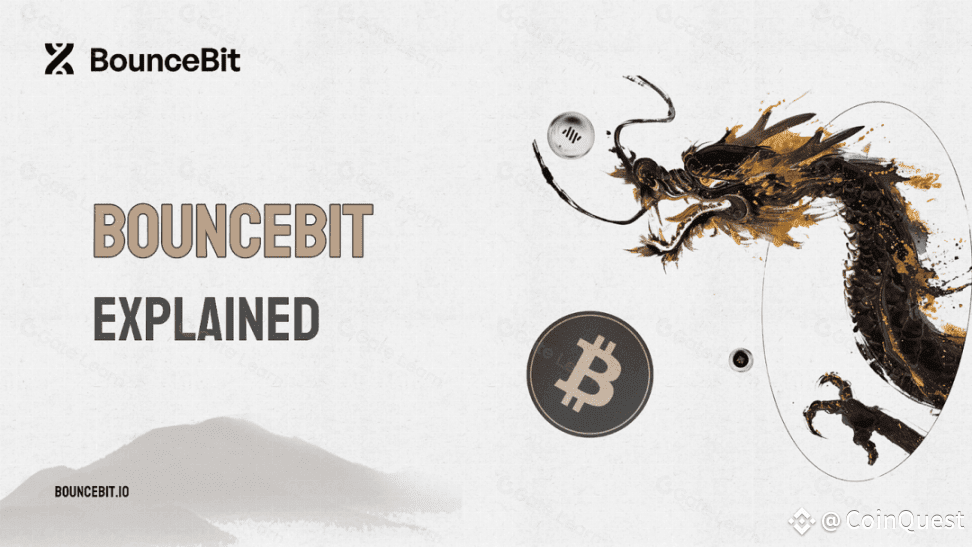
The core innovation of BounceBit comes from the BTC re-staking mechanism, and this new concept is the key to promoting the project’s development. BounceBit will build a range of infrastructure to explore the use of restaking on various Bitcoin types, which can be in the form of sidechains, oracles, bridges, virtual machines, data availability layers, etc. The goal is to underpin the framework through re-staking and aggregated shared security.
By integrating Bitcoin into a proof-of-storage (PoS) layer-1 network, BounceBit redefines Bitcoin’s role in the blockchain ecosystem. BounceBit not only expands the utility of the world’s first cryptocurrency, but also pioneers a token economic model that promises scalability, security, and inclusiveness.
Run the core mechanism
2.1 Re-staking mechanism
One of BounceBit’s core innovations is its BTC re-staking mechanism. Users can convert their Bitcoin into BBTC and then stake it on the BounceBit platform to earn rewards. This mechanism not only increases Bitcoin’s liquidity but also increases its usability in the DeFi ecosystem.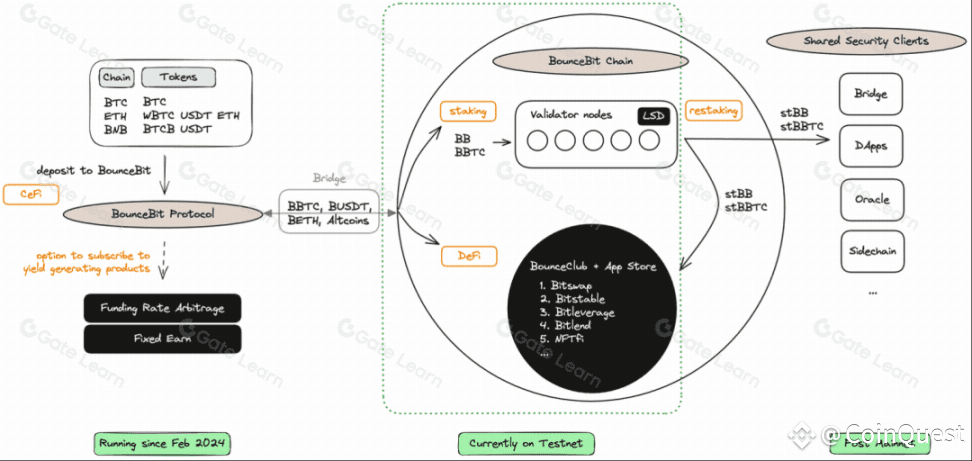
The following is a detailed introduction to BounceBit’s re-staking mechanism:
2.1.1 Basic concepts
The re-staking mechanism is based on converting traditional cryptocurrencies such as Bitcoin into a new form that can be used on the BounceBit platform, commonly known as BBTC. This conversion allows Bitcoin, which originally did not have the staking function, to participate in the staking and consensus process, thereby adding additional benefits while maintaining its value.
2.1.2 Steps and processes
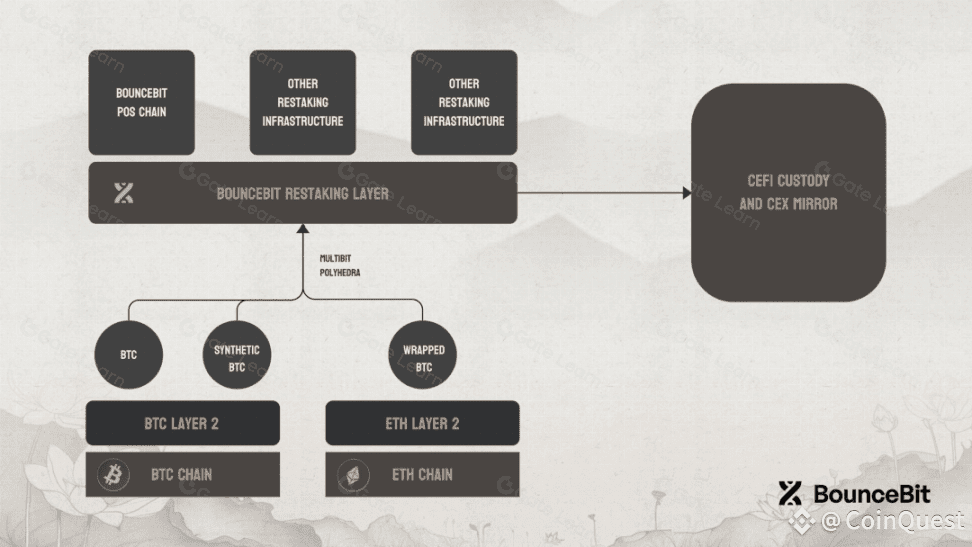
Conversion to BBTC: Users first convert
their Bitcoin holdings into BBTC. This process is done via BounceBit’s cross-chain bridge or directly on its platform. The converted BBTC represents the user’s value of Bitcoin on the original chain.
Staking BBTC: Once Bitcoin is converted into BBTC, users can stake it on the BounceBit platform. By staking BBTC, users help promote the security of the platform, helping maintain the stability of the network and verify transactions.
Earn rewards: Users who participate in staking can receive rewards, which can be BBTC or BB, another native token of the platform. These rewards come from network transaction fees, rewards for the generation of new blocks, or other economic activities.
2.2 Dual Token System
BounceBit’s dual-token system is a key design feature that enables the platform to effectively enhance network security, provide flexible staking mechanisms, and facilitate user participation in its governance structure. This system includes two tokens with different functions: BB and BBTC. Here’s a detailed look at both tokens and how they work on the BounceBit platform:
2.2.1 BB Token
BB is BounceBit’s native governance token
2.2.1.1 Main purpose
Network governance: BB token holders can participate in the platform’s governance decisions, including proposals and voting. This governance model enables community members to directly influence the development direction of the platform and the adjustment of key parameters.
Staking rewards: BB tokens can be staked in the network to support its operations, and stakers can receive transaction fees and other incentives in return.
Security: By staking BB tokens, users help maintain the security of the network and prevent double spending and other types of attacks.
The BB token is designed to incentivize holders to actively participate in the maintenance and governance of the platform, thereby ensuring the healthy development and long-term success of the network.
2.2.1.2 Token distribution
The total supply of BounceBit tokens is 21 billion, and their distribution is as follows: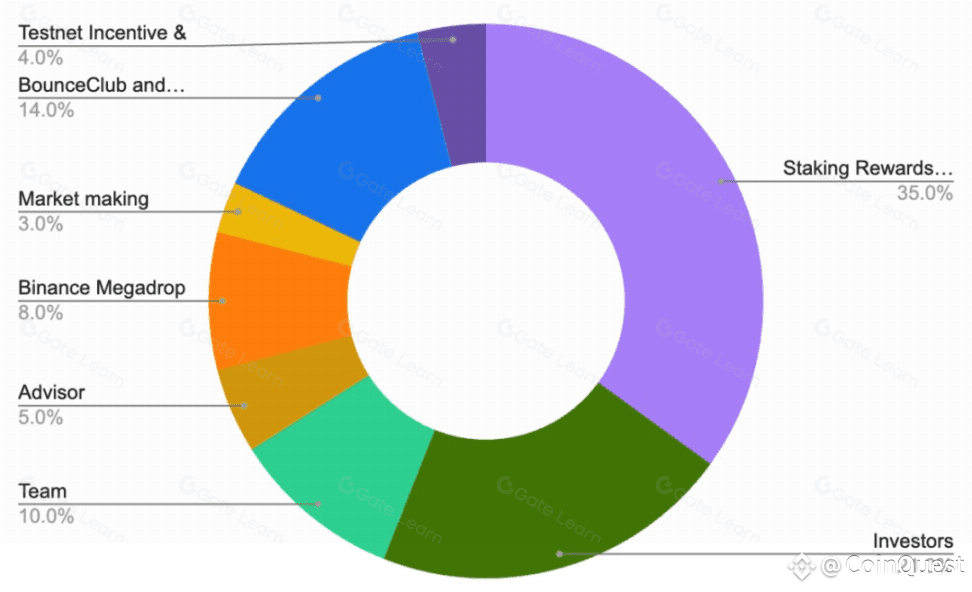
Staking reward: 35%, used to reward users who provide staking services for the BounceBit network.
Market: 3%, used to incentivize liquidity providers to provide liquidity for BounceBit trading pairs.
Binance Megadrop: 8% for airdropping BB tokens to the public via Binance Launchpad.
Testnet incentives: 4%, used to reward testnet participants.
Consultants: 5%, used to reward consultants on the BounceBit project.
Team: 10%, used to reward team members of the BounceBit project.
BounceClub and Ecological Reserve: 14% to support the development and growth of the BounceBit ecosystem.
Investors: 21%, used to reward early investors.
2.2.1.3 BounceBit Token Release Schedule
BounceBit tokens will be gradually unlocked over four years, with the specific schedule as follows: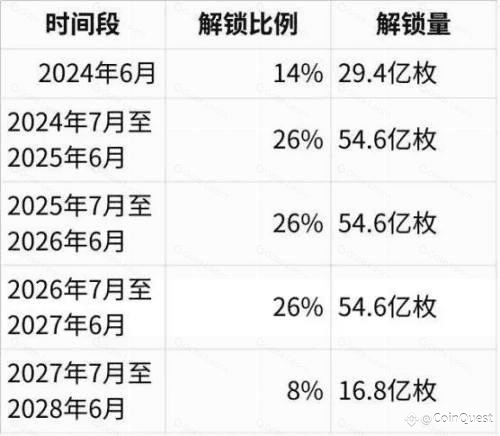
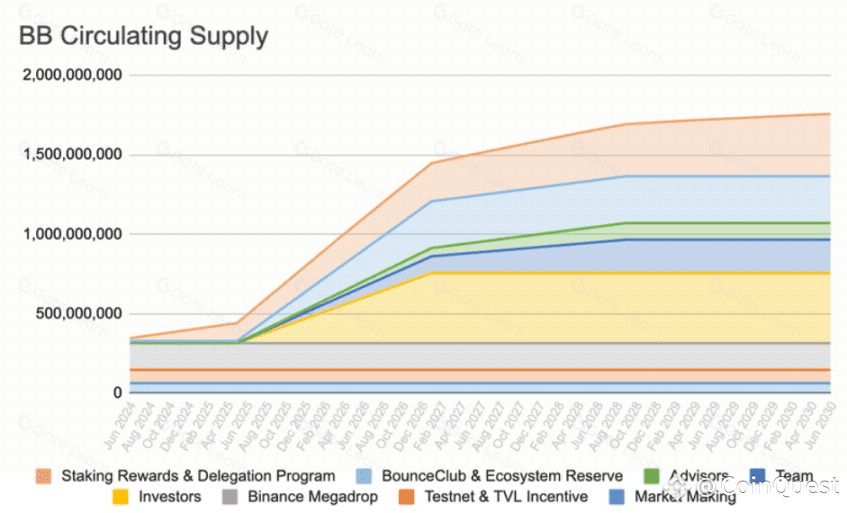
2.2.2 BBTC Token
BBTC is a token pegged to the value of Bitcoin and is primarily used to enable wider adoption of Bitcoin on the BounceBit platform. Its main features and uses include:
Increase the liquidity and usability of Bitcoin: Users can convert their Bitcoin to BBTC and then use it on the BounceBit platform to participate in various staking and investment opportunities, such as DeFi projects.
Cross-chain function: BBTC can be freely transferred between different blockchains, allowing Bitcoin to be circulated and used in a wider blockchain ecosystem.
Participate in staking and earn income: By converting Bitcoin to BBTC, users not only maintain the value of Bitcoin but also earn additional income by staking BBTC.
BBTC is designed to solve the problems of lower liquidity and fewer application scenarios of Bitcoin on the native chain. Through BBTC, Bitcoin can participate in various blockchain activities more flexibly.
BounceBit’s dual-token system not only provides diverse economic incentives, but also maintains the security and stability of the network through a unique dual-token consensus mechanism. Under this mechanism, validators need to stake BB or BBTC to participate in the consensus process of the network.
This dual-token design enhances the security of the network as it requires participants to hold at least one of the two tokens, thereby increasing the economic cost of attacks on the network.
2.3 DeFi & CeFi Integration
BounceBit’s DeFi (decentralized finance) and CeFi (centralized finance) integration is one of the core features of the platform, which is committed to creating a bridge that seamlessly combines the traditional financial world with blockchain technology. This integration not only provides users with a wider selection of financial instruments and services, but also enhances liquidity and access to funds.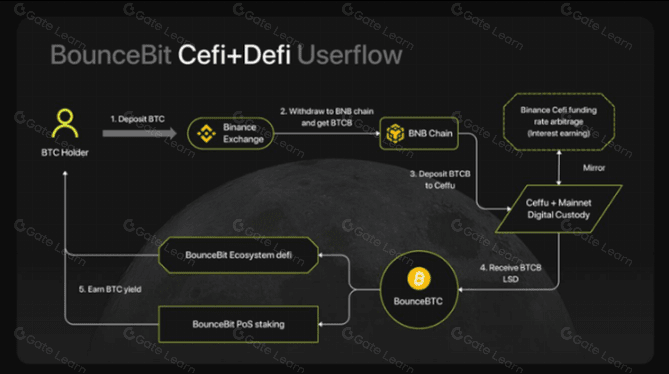
Here’s a detailed look at how BounceBit implements DeFi and CeFi integration:
2.3.1 DeFi integration
Smart contract platform:
BounceBit is built on compatibility with the Ethereum Virtual Machine (EVM), enabling it to execute smart contracts. This feature allows developers to deploy and run a variety of decentralized applications (DApps) on the BounceBit platform, including lending platforms, automated market makers (AMMs), and other financial protocols.
Liquidity Protocol:
By providing a built-in liquidity protocol, BounceBit enables users to stake and lend their crypto assets. These protocols often take the form of liquidity pools into which users can deposit their crypto assets in exchange for a share of trading fees or other forms of revenue.
Tokenized assets:
BounceBit supports tokenized assets such as BBTC, which allows traditional crypto assets such as Bitcoin to be more active in the decentralized financial ecosystem, and users can use these assets to participate in broader DeFi activities.
2.3.2 CeFi integration
Regulated Partners:
BounceBit partners with regulated financial institutions to provide centralized financial services. These services include asset custody, fiat currency exchange and credit services. In this way, BounceBit ensures that financial activities on the platform comply with relevant regulatory requirements.
Asset liquidity and security:
On the CeFi side, BounceBit provides liquidity management and safeguards for crypto assets. Collaborating centralized institutions can provide faster transaction processing speeds and higher transaction capacity while providing insurance and other security measures for user assets.
User interface and experience:
BounceBit strives to eliminate the boundaries between DeFi and CeFi in terms of user experience. By providing a unified interface, users can seamlessly switch between decentralized and centralized financial products, enjoying the advantages of both without the need to frequently change platforms or wallets.
2.3.3 Bridging DeFi and CeFi
Dual-token mechanism and liquidity:
BounceBit’s dual-token system (BB and BBTC) provides a liquidity bridge for the integration of DeFi and CeFi. Users can use these tokens in DeFi protocols to earn yield, or trade and redeem them on CeFi platforms.
Cross-chain technology:
BounceBit uses cross-chain technology to realize the free movement of assets between different blockchains, enhancing its support for different financial fields and allowing users to access multi-chain assets on one platform.
2.4 Proof of Stake (PoS)
BounceBit uses a unique Proof of Stake (PoS) consensus mechanism that not only enhances the security of the network, but also improves its energy efficiency and scalability. In BounceBit’s PoS system, node operators need to stake tokens (such as BB or BBTC) to participate in the network’s consensus process and verify transactions. The following is a detailed introduction to the BounceBit PoS consensus mechanism:
2.4.1 Basic principles of PoS consensus mechanism
PoS (Proof of Storage) is a blockchain consensus mechanism that, compared with Proof of Work (PoW), ensures the security and integrity of the network by holding tokens. In PoS, validators are selected based on the number of tokens they hold and how long they hold them, rather than their ability to solve complex computational problems.
2.4.2 PoS features of BounceBit
Dual Token Staking: BounceBit allows users to use two types of tokens—BB and BBTC—to participate in staking and network validation. This increases the diversity of participants and provides more staking flexibility.
Elect validators: In BounceBit’s PoS system, token holders can vote to elect trusted nodes as network validators. This process promotes the decentralization of power and increases the decentralization of the network.
Reward mechanism: Verifiers participating in PoS staking can receive transaction fees and newly generated tokens as rewards. This reward mechanism encourages more users to join the staking and enhances the security of the network.
Security and Stability: By requiring validators to stake large amounts of tokens, BounceBit’s PoS system increases the cost of launching attacks, thereby improving the security of the network.
Energy efficiency and high efficiency: Compared with PoW, the PoS mechanism is more efficient in energy consumption. BounceBit’s adoption of PoS not only reduces environmental impact, but also improves transaction processing speed and network scalability.
2.4.3 Roles and Responsibilities of Verifiers
In BounceBit’s PoS system, validators bear the responsibility for key operations of the network, including:
Verifying transactions: Validators are responsible for checking and confirming transactions on the network, ensuring their legality and correctness.
Generate new blocks: Validators participate in generating new blocks that record all transactions that have occurred on the network since the previous block.
Maintaining network security: Validators help prevent double spending and other types of network attacks through ongoing network participation and monitoring.
2.5 Liquidity and cross-chain operations
BounceBit’s liquidity and cross-chain operations are an important part of its platform’s capabilities, aiming to increase the efficiency and accessibility of crypto assets while connecting different blockchain networks. These features are critical to building an open, connected blockchain ecosystem, allowing assets to flow freely and users to seamlessly conduct transactions and other financial activities across multiple platforms. The following is a detailed introduction to the functions and implementation of BounceBit in these two aspects:
2.5.1 Liquidity Management
On the BounceBit platform, liquidity management is implemented through a variety of mechanisms and tools to ensure that users can trade and use their assets efficiently and conveniently.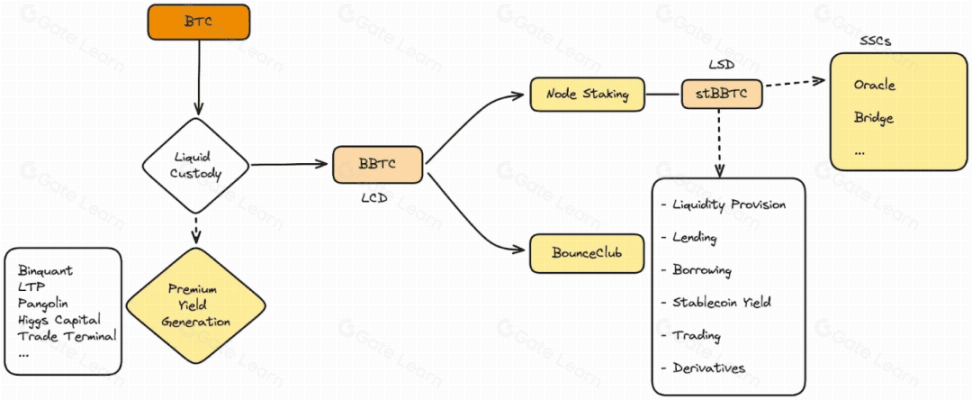
Key liquidity features include
Liquidity pool:
BounceBit utilizes liquidity pools to increase the liquidity of assets within the platform. These pools are typically funded by users, who in turn receive a portion of transaction fees in return.
Liquidity pools support a variety of transactions, including token swaps, lending operations, and other complex financial instruments.
Automated Market Maker (AMM):
BounceBit can integrate AMM models, allowing decentralized trading without the need for traditional order books. Users can directly interact with smart contracts and buy and sell assets through preset algorithms, which improves the efficiency and predictability of transactions.
Staking and reward mechanism:
To further increase liquidity on the platform, BounceBit encourages users to stake their tokens (such as BB or BBTC) to support network operations and provide liquidity. In return, users can receive staking rewards, including newly issued tokens or a portion of transaction fees.
2.5.2 Cross-chain operations
Cross-chain technology enables BounceBit to connect multiple different blockchain networks, allowing assets to move freely between different chains. This is a key technology to enable widespread blockchain adoption and feature expansion.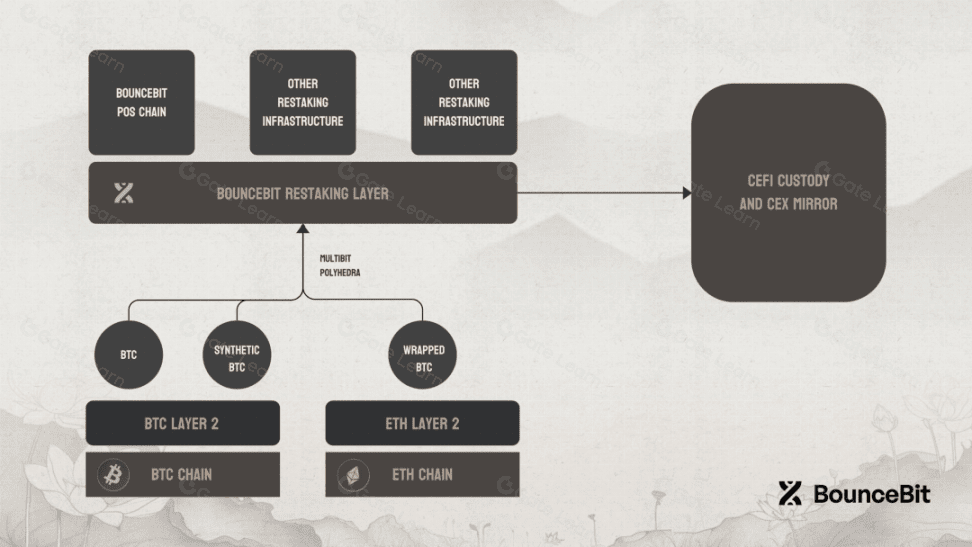
How to implement cross-chain functions
Cross-chain bridge:
BounceBit develops and maintains cross-chain bridges that allow assets like BBTC to be transferred from one blockchain to another. This transfer is secured and transparent through smart contracts.
Bridge operations can be one-way or two-way, depending on the specific asset and target chain needs.
Compatibility and interoperability:
BounceBit ensures that its platform is technically compatible with other major blockchain protocols such as Ethereum, Binance Smart Chain, and others. This includes supporting standardized token protocols (such as ERC-20) so that these tokens can be issued and traded on different chains.
Decentralized authentication and security:
Cross-chain operations require a high degree of security, and BounceBit ensures the security and tamper-proofness of cross-chain transactions through multi-signatures, smart contract verification, and other crypto technologies.
2.6 Three-party ecosystem
BounceBit’s three-party ecosystem is a key component of its platform structure, designed to facilitate interaction and collaboration among multiple participants to drive healthy growth and innovation throughout the network. This ecosystem includes three main roles: users (network participants), BB holders, and node operators.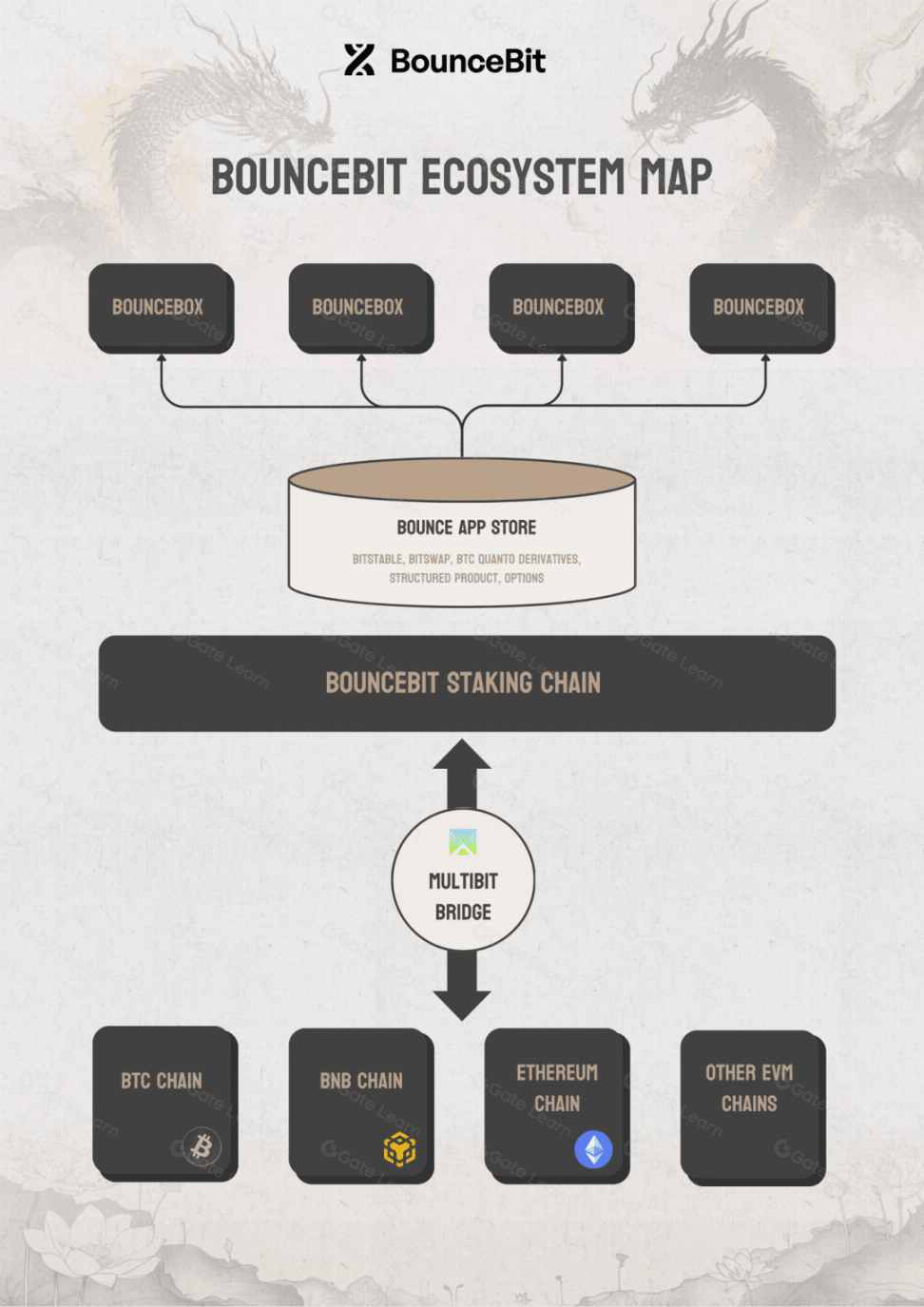
Below is a detailed introduction to these three roles and their functions and roles in the BounceBit ecosystem:
2.6.1 Users (network participants)
Users are the foundation of the BounceBit ecosystem and interact with the platform in a variety of ways:
Transaction initiator: Users can initiate and execute transactions, such as transfers, purchases, sales, etc.
DApps Users: Users can utilize decentralized applications (DApps) deployed on the BounceBit platform, such as lending platforms, exchanges, games, etc.
Staking participants: Users can participate in the security maintenance of the network by staking BB or BBTC and obtain possible benefits at the same time.
The activity of such participants directly affects the vitality and sustainable development of the network, and their trading behaviour and staking decisions are also important drivers of network demand and expansion.
2.6.2 BB holders
BB holders have key governance roles in BounceBit’s ecosystem:
Governance voting: Users holding BB tokens can participate in the governance decisions of the network, including voting on key decisions such as protocol updates and fee structure adjustments.
Staking and Earnings: BB holders can stake their tokens in the network to support the safe operation of the network and receive staking rewards.
Community Building: BB holders are generally more invested in the long-term success of the platform, and they may participate in community building and promotional activities to help increase BounceBit’s visibility and attract new users.
The decisions of this group are critical to the future direction and development of the platform, and their participation ensures that BounceBit can move forward in the common interest of its holders.
2.6.3 Node operator
Node operators are technical participants who maintain the security and efficient operation of the BounceBit network:
Transaction verification and block generation: Node operators are responsible for verifying transactions on the network and participating in generating new blocks. This is a critical responsibility to maintain the integrity and continuity of the blockchain.
Network security maintenance: By running full nodes, node operators help the network defend against potential attacks and failures.
Technical support and innovation: Node operators are often technological pioneers and may develop new tools and features to improve network performance and user experience.
The stability and reliability of node operators directly affect the health of the entire network. They play the role of infrastructure providers in the entire ecosystem and are an important bridge connecting users and holders.
2.7 LSD(Liquid Staking Derivative)
BounceBit’s LSD (Liquid Staking Derivative) flexible staking mechanism is an innovative feature of the platform, which allows users to stake cryptocurrencies without sacrificing the liquidity of the asset. This mechanism is particularly suitable for users who want to earn income from their crypto-asset holdings without locking up their assets. LSD solves the problem of asset illiquidity in traditional staking methods by creating a derivative that represents the staked asset. The following is a detailed introduction to BounceBit’s LSD flexible staking:
2.7.1 How LSD works
Asset staking:
Users first select the asset they wish to stake, such as BB or BBTC, etc. These assets are typically locked in a smart contract to support the network’s security or participate in a consensus mechanism.
Release LSD:
Once the assets are locked, users will receive corresponding liquid staking derivatives (LSD), such as stBB or stBBTC. These derivative tokens can be freely traded in the market, and users can use them for other investments or transactions without affecting the security of the original staked assets.
Benefits and rewards:
While the original asset is locked, users can still earn staking rewards by holding LSD. These rewards are often related to network security, transaction fee sharing, or new block generation.
2.7.2 Advantages of LSD
Enhance liquidity:
The biggest advantage of LSD is that it allows users to keep their assets liquid. Even while participating in staking, users are still free to use or trade their LSD tokens.
This article isn’t complete yet. You keep the remaining part; I’ll share it later.
#BounceBitPrime $BB @BounceBit #BTCBreaksATH #GoldHitsRecordHigh




